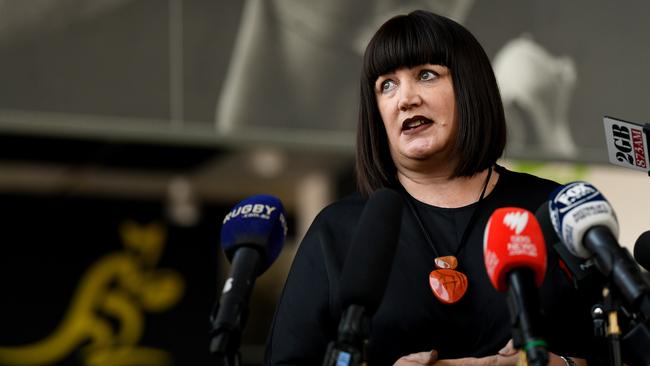Rugby’s TV deal key to keeping talent
If the broadcast deal comes up short, get ready for a mass exodus of Australian players to overseas clubs.

It’s not just the new broadcast deal that is occupying Rugby Australia and its chief executive Raelene Castle this year.
There is also a collective bargaining agreement to work out with its professional players and it is very much a case of one deal very much influencing the other.
RA is hoping to have its broadcast deal for 2021-25 resolved by the end of next month and discussions have already begun with the Rugby Union Players Association and its CEO, former Wallabies second-rower Justin Harrison.
And while RA is hoping to find a broadcaster which will support its vision for the growth of the game, the bottom line is that the financial element is desperately important and doubly so to RUPA because the future of its members is riding on it. If the broadcast deal comes up short and cannot guarantee the survival of the four Super Rugby franchises, get ready for a mass exodus of Australian players to overseas clubs.
“Without putting all of the weight on the importance of it, certainly a big driver of it is going to be what iteration of broadcast deal they (RA) come up with,” Harrison told The Australian.
That said, Harrison is not going to second-guess RA’s current tactics in going to the open market in search of a broadcaster.
“We haven’t been privy to those sorts of discussions so it would be wrong of me to offer an opinion because speculation and instability are not healthy for any part of this story. Our role is to be engaged and to recognise the opportunity for positive change.”
As a recent employee of Rugby Australia as the boss of the Classic Wallabies program, Harrison is well acquainted with both the objective of the national body and of the playing group. And one thing he insists the players aren’t driven by — and this will confound many of their critics — is money.
“None of the discussions from the players has been about numbers. It has been about how do we engage each other and present ourselves as a sport that is a healthy sport,” he said.
“We’ve used it (the upcoming CBA negotiations) as an opportunity to go on a bit of a road trip to make sure that we get the language and the appropriate representation of the players, because I may be a retired lion but I can’t do anything until the players tell me what their desires are.
“And one thing that I have been warmly reminded of is that the players are acutely aware of the need to connect with the game at all levels. We’re very keen to explore something that joins all levels of the game together so we don’t see a continuation of the perception that the professional game has forgotten its origins.
“The players are professional but the feedback we’re getting is their appetite to engage in the communities they are engaging in and the rugby bodies they are representing has never been higher.”
He is as frustrated as his members that rugby still has no clear vision of the future. Certainly the immediate future to 2025 has been mapped out, with more of the same continuing in Super Rugby, although from next year the conference system will be replaced by a round robin competition.
Beyond that, however, all is obscured, with even one of the founding pillars of SANZAAR, South Africa, suggesting it might move north to join the Six Nations.
“The players are aware that the current model needs refining and certainly needs to be designed to engage its immediate fan base,” Harrison said.
“We’ve forgotten about one of the most important stakeholders in this whole equation, the supporter base and reintroducing them into that storyline is paramount to us.”



To join the conversation, please log in. Don't have an account? Register
Join the conversation, you are commenting as Logout